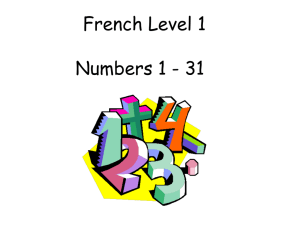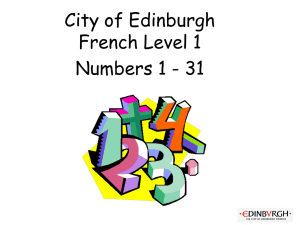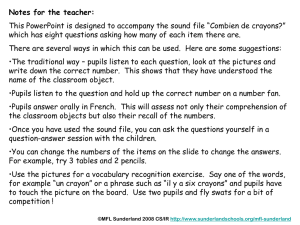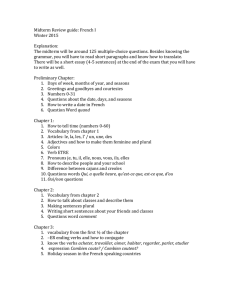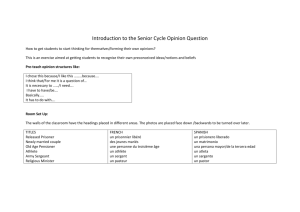French Level 2 Numbers.ppt - Edinburgh Modern Languages
advertisement
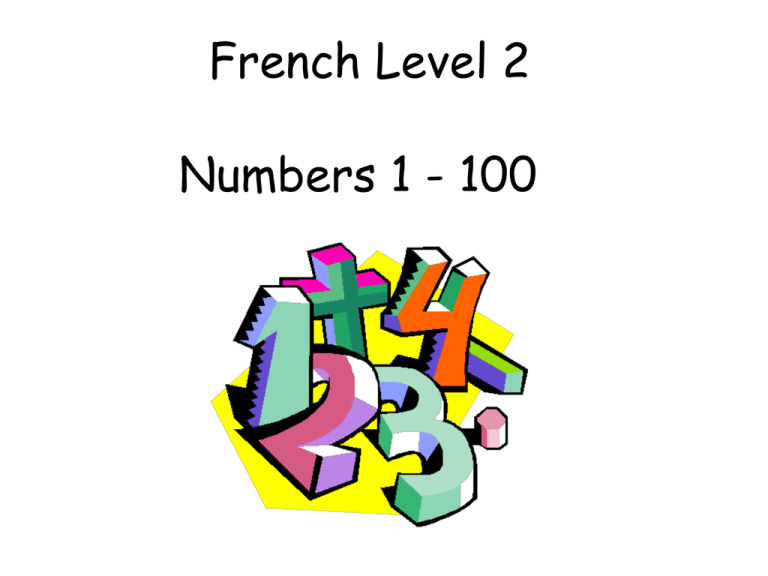
French Level 2 Numbers 1 - 100 Second Level Significant Aspects of Learning • Actively take part in daily routine • Understand and respond to classroom instructions and personal information from familiar sources • Listen, join in and respond to a story, song or poem • Participate in familiar games, paired speaking and short role plays • Further develop an understanding of, interest in and respect for other countries, cultures and languages • Demonstrate an appreciation and understanding of the value of language learning including skills for life and work • Take part in simple, paired conversations about themselves, others and interests of their choice • Ask for help confidently using learned phrases and familiar language • Give a short presentation about a familiar topic • Pronounce words sufficiently accurately so as to make the meaning clear • Work with others and make a successful contribution to a group presentation in English supported by the target languages Second Level Significant Aspects of Learning • Read aloud a simple text • Read and understand a variety of simple texts • Make comparisons between English and target language (including use of a bi-lingual dictionary with support) • Write about themselves and others and check the accuracy of own writing • Exchange straightforward information in writing using familiar words and phrases Numbers 1 - 31 Combien? How many? un deux trois quatre cinq six sept huit neuf dix onze douze treize quatorze quinze seize dix-sept dix-huit dix-neuf vingt one two three four five six seven eight nine ten eleven twelve thirteen fourteen fifteen sixteen seventeen eighteen nineteen twenty Numbers 1 - 31 vingt et un vingt-deux vingt-trois vingt-quatre vingt-cinq vingt-six vingt-sept vingt-huit vingt-neuf trente trente et un trente-deux Quarante Quarante et un twenty-one twenty-two twenty-three twenty-four twenty-five twenty-six twenty-seven twenty-eight twenty-nine thirty thirty-one thirty-two forty forty-one Cinquante Cinquante et un Soixante Soixante et un Soixante-dix Soixante et onze Quatre-vingts Qautre-vingt-un Quatre-vingt-dix Quatre-vingt-onze Cent fifty fifty-one sixty sixty-one seventy seventy-one eighty eighty-one ninety ninety-one one hundred Combien? un deux trois quatre cinq six sept huit neuf dix onze douze treize quatorze quinze seize dix-sept dix-huit dix-neuf vingt vingt et un vingt-deux vingt-trois vingt-quatre vingt-cinq vingt-six vingt-sept vingt-huit vingt-neuf trente trente et un Embedding the language You can use numbers to count things throughout your lessons. Combien challenge! Every time the teacher calls, “combien?” the pupils have to count whatever they have in front of them and then say it in French. Once you have learnt the days of the week and the months, you can use the numbers for dates at the start of every day. I have explored numbers, understanding that they represent quantities, and I can use them to count, create sequences and describe order. MNU 0-02a Sample activities You will find a bank of sample activities which you can use to practice the vocabulary in the classroom. This is not a prescriptive list of activities and you can use or adapt them to suit the needs of your class. You will find a set of more supported activities in Early Feelings and more challenging activities in Level 2 Feelings. 1 – 20 counting rhyme Cache, cache, compte, compte! 1. Cache cache compte compte means hide hide count count in French. The teacher has an object which will then be hidden somewhere in the class. A teddy for example. 2. One pupil leaves the class and another pupil hides the object somewhere in the room. 3. The pupil who was outside now comes back in and must find the hidden object whilst the rest of the class count in French, getting louder as they get nearer to the object and quieter as they get further away (like hot and cold). 4. You can get them to count to whichever number you are working up to (e.g. 20) and then repeat it twice to give them enough time to look. I have explored numbers, understanding that they represent quantities, and I can use them to count, create sequences and describe order. MNU 0-02a Cache cache, compte, compte Une personne sort de la classe Une personne cache le jouet Cache cache, compte, compte La personne rentre dans la classe… et cherche le jouet! On compte FORT On compte si la personne est proche de jouet. si la personne est loin de jouet. doucement Round class counting 1. Give everyone in the class a number from 1 – 31 (or however high you are counting to at the time). You can double up numbers if this doesn’t work out with the number of pupils in the class. 2. Ask them to each write their number (as a number) on a sheet of paper in front of them. 3. Now go round the class with each pupil standing and shouting out their individual number as you count up. 4. Once they get become more confident, you can time them doing this around the class and see if they can beat their own time. 5. Shuffle pupils around so that they are in a different seat but with the same numbers and repeat the activity. 6. Shuffle pupils again so that they get a new number. 7. This activity could be done in a circle to make it easier to organise. Action numbers With the class, choose an action to go with each of the numbers to help teach them. You might want them to do this in pairs , share with groups and then choose the best ones which will make up the class actions. e.g. un = hitting a tennis ball deux = a punch trois = a guitar strum quatre = a cat gesture You can then follow this up by doing the action and getting them to say the numbers. Onze! 1. Pupils stand in a circle 2. They will then count to 11 with each person saying either 1, 2 or 3 numbers e.g. Sophie 1, 2 – Tom – 3,4,5 – Danny – 6, 7 etc. 3. Whoever lands on the number 11 is then out and sits down. 4. The winner is the last person standing. Formez un cercle au centre de la classe Onze! Comptez un, deux ou trois nombres Par exemple… Personne a: 1, 2 Personne b: 3,4,5 Personne c: 6 La personne qui dit, “11” est éliminée! La dernière personne gagne! Il y a combien? 1. Teacher shows the following pictures and pupils have to count them up and say how many there are. 2. Each time teacher asks the class – Il y a combien? (how many are there?). As you move through the images, get the class to join in with the question. 3. Following on from this you can do a paired/group activity with different objects on each table. 4. Pupils ask their partners/groups to fermez les yeux (close your eyes) and they take away or add objects to those in the centre. 5. They then ask their partner/group to ouvrez les yeux (open your eyes) and ask the question, il y a combien? 6. They then answer il y a ___ and how ever many there are. Il y a combien? Il y a combien? Il y a combien? Il y a combien? Il y a combien? Il y a combien? Lotto! Dessinez six cases 12 6 5 4 20 1 Choisissez et écrivez six numéros entre 1 et 20. Lotto! Dessinez six cases 12 16 15 14 20 11 Choisissez et écrivez six numéros entre 10 et 20. Lotto! Dessinez six cases 12 6 5 4 20 1 Choisissez et écrivez six numéros entre 10 et 31. Songs! You will find a bank of sample songs which you can use to practice the vocabulary in the classroom. This is not a prescriptive list of songs and you can use or adapt them to suit the needs of your class. You will find a set of more supported activities in Early Feelings and more challenging activities in Level 2 Feelings. Comptez et chantez! trente-deux trente-trois trente-quatre trente-cinq trente-six trente-sept trente-huit trente-neuf quarante quarante et un quarante-deux quarante-trois quarante-quatre quarante-cinq quarante-six quarante-sept quarante-huit quarante-neuf cinquante cinquante et un cinquante-deux cinquante-trois cinquante-quatre cinquante-cinq cinquante-six cinquante-sept cinquante-huit cinquante-neuf soixante soixante et un soixante-deux soixante-trois soixante-quatre soixante-cinq soixante-six soixante-sept soixante-huit soixante-neuf soixante-dix soixante et onze soixante-douze soixante-treize soixante-quatorze soixante-quinze soixante-seize soixante-dix-sept soixante-dix-huit soixante-dix-neuf quatre-vingts quatre-vingt-un quatre-vingt-deux quatre-vingt-trois quatre-vingt-quatre quatre-vingt-cinq quatre-vingt-six quatre-vingt-sept quatre-vingt-huit quatre-vingt-neuf quatre-vingt-dix quatre-vingt-onze quatre-vingt-douze quatre-vingt-treize quatre-vingt-quatorze quatre-vingt-quinze quatre-vingt-seize quatre-vingt-dix-sept quatre-vingt-dix-huit quatre-vingt-dix-neuf cent Sample activities You will find a bank of sample activities which you can use to practice the vocabulary in the classroom. This is not a prescriptive list of activities and you can use or adapt them to suit the needs of your class. You will find a set of more supported activities in Early Feelings and more challenging activities in Level 2 Feelings. Splat This game can be played with two teams (rouge et bleu) or with 2 individuals going head to head. Write words/numbers on the board. Get two pupils out to the front of the class. Give the two different coloured board pens. Teacher/pupils say a word, pupils then have to circle it. The one who circles it first wins/ wins the point. Splat! Je vais écrire les números sur le tableau Splat! Il faut deux volontaires. Venez ici, en face du tableau. Splat! Un volontaire a un stylo bleu et l’autre a un stylo rouge. Splat! Je vais dire un numéro, par exemple: Splat! La personne qui cercle le bon numéro en premier a gagné! Cent The object: to be the first to score 100 points or more. How to play: Players take turns rolling two dice and following these rules: 1. On a turn, a player may roll the dice as many times as he or she wants, mentally keeping a running total of the sums that come up. When the player stops rolling, he or she records the total and writes it in French and adds it to the scores from previous rounds. 2. But, if a 1 comes up on one of the dice before the player decides to stop rolling, the player scores 0 for that round and it's the next player's turn. 3. Even worse, if a 1 comes up on both dice, not only does the turn end, but the player's entire accumulated total returns to 0. Cache, cache, compte, compte! 1. Cache cache compte compte means hide hide count count in French. The teacher has an object which will then be hidden somewhere in the class. A teddy for example. 2. One pupil leaves the class and another pupil hides the object somewhere in the room. 3. The pupil who was outside now comes back in and must find the hidden object whilst the rest of the class count in French, getting louder as they get nearer to the object and quieter as they get further away (like hot and cold). 4. You can get them to count to whichever number you are working up to (e.g. 20) and then repeat it twice to give them enough time to look. I have explored numbers, understanding that they represent quantities, and I can use them to count, create sequences and describe order. MNU 0-02a Cache cache, compte, compte Une personne sort de la classe Une personne cache le jouet Cache cache, compte, compte La personne rentre dans la classe… et cherche le jouet! On compte FORT On compte si la personne est proche de jouet. si la personne est loin de jouet. doucement Round class counting 1. Give everyone in the class a number from 31-100(or however high you are counting to at the time). You can double up numbers if this doesn’t work out with the number of pupils in the class. 2. Ask them to each write their number (as a number) on a sheet of paper in front of them. 3. Now go round the class with each pupil standing and shouting out their individual number as you count up. 4. Once they get become more confident, you can time them doing this around the class and see if they can beat their own time. 5. Shuffle pupils around so that they are in a different seat but with the same numbers and repeat the activity. 6. Shuffle pupils again so that they get a new number. 7. This activity could be done in a circle to make it easier to organise. Lotto! Dessinez six cases 41 34 44 36 32 38 Choisissez et écrivez six numéros entre 31-45. Lotto! Dessinez six cases 45 52 64 58 51 69 Choisissez et écrivez six numéros entre 45-69. Lotto! Dessinez six cases 72 86 99 100 78 84 Choisissez et écrivez six numéros entre 69-100 Songs! You will find a bank of sample songs which you can use to practice the vocabulary in the classroom. This is not a prescriptive list of songs and you can use or adapt them to suit the needs of your class. You will find a set of more supported activities in Early Feelings and more challenging activities in Level 2 Feelings. ICT Resources online You will find a bank of sample ICT activities which you can use to practice the vocabulary in the classroom. This is not a prescriptive list of activities and you can use or adapt them to suit the needs of your class. You will find a set of more supported activities in Early Feelings and more challenging activities in Level 2 Feelings. Each of the slides contains an image of the website page. If you click on the image it will take you to the page. Alternatively you can use a link address which you will find in the slide notes. Languages Online Languages Online Australia Classtools.net L’institut français BBC French – Numbers 1 - 100 Au revoir!
